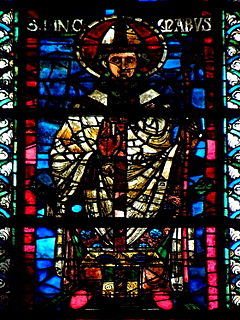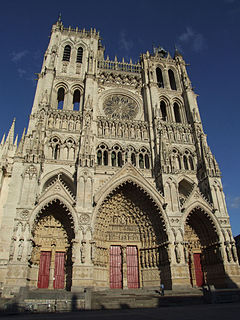
Ralph d'Escures was a medieval Abbot of Séez, Bishop of Rochester and then Archbishop of Canterbury. He studied at the school at the Abbey of Bec. In 1079 he entered the abbey of St Martin at Séez, and became abbot there in 1091. He was a friend of both Anselm of Canterbury and Gundulf, Bishop of Rochester, whose see, or bishopric, he took over on Gundulf's death.

Hincmar, archbishop of Reims, was a Frankish jurist and theologian, as well as the friend, advisor and propagandist of Charles the Bald. He belonged to a noble family of northern Francia.

The Roman Catholic Archdiocese of Reims is an archdiocese of the Latin Rite of the Roman Catholic Church in France. Erected as a diocese around 250 by St. Sixtus, the diocese was elevated to an archdiocese around 750. The archbishop received the title "primate of Gallia Belgica" in 1089.

The Roman Catholic Diocese of Beauvais, Noyon, and Senlis is a diocese of the Latin Rite of the Roman Catholic Church in France. The diocese encompasses the department of Oise in the region of Hauts-de-France. The diocese is a suffragan of the Archdiocese of Reims. The current bishop is Jacques Benoit-Gonnin, appointed in 2010.

Tilpin, whose name was corrupted in legend as Turpin, was the bishop of Reims from about 748 until his death. He was for many years regarded as the author of the legendary Historia Caroli Magni, which is thus also known as the "Pseudo-Turpin Chronicle". He appears as one of the Twelve Peers of France in a number of the chansons de geste, the most important of which is The Song of Roland. His portrayal in the chansons, often as a warrior-bishop, is completely fictitious.
Herbert II, Count of Vermandois, Count of Meaux, and Count of Soissons. He was the first to exercise power over the territory that became the province of Champagne.

Ebbo or Ebo was archbishop of Rheims from 816 until 835 and again from 840 to 841. He was born a German serf on the royal demesne of Charlemagne. He was educated at his court and became the librarian and councillor of Louis the Pious, king of Aquitaine, son of Charlemagne. When Louis became emperor, he appointed Ebbo to the see of Rheims, then vacant after the death of Wulfaire.
Reginald fitz Jocelin was a medieval Bishop of Bath and an Archbishop of Canterbury-elect in England. A member of an Anglo-Norman noble family, he was the son of a bishop, and was educated in Italy. He was a household clerk for Thomas Becket, but by 1167 he was serving King Henry II of England. He was also a favourite of King Louis VII of France, who had him appointed abbot of the Abbey of Corbeil. After Reginald angered Becket while attempting to help negotiate a settlement between Becket and the king, Becket called him "that offspring of fornication, that enemy to the peace of the Church, that traitor." When he was elected as a bishop, the election was challenged by King Henry's eldest son, Henry the Young King, and Reginald was forced to go to Rome to be confirmed by Pope Alexander III. He attended the Third Lateran Council in 1179, and spent much of his time administering his diocese. He was elected Archbishop of Canterbury in 1191, but died before he could be installed.

The Roman Catholic Diocese of Coutances (–Avranches) is a diocese of the Roman Catholic Church in France. Its mother church is the Cathedral of Coutance in the commune of Coutances in France. The diocese is suffragan of the Archbishop of Rouen and comprises the entire department of Manche. It was enlarged in 1802 by the addition of the former Diocese of Avranches and of two archdeaconries from the Diocese of Bayeux. Since 1854 its bishops have held the title of Bishop of Coutances (–Avranches).
The Synod of Thionville was an important synod of ecclesiastic dignitaries of the Carolingian Empire in 835.
The Councils of Clovesho or Clofesho were a series of synods attended by Anglo-Saxon kings, bishops, abbots and nobles in the 8th and 9th centuries. They took place at an unknown location in the Kingdom of Mercia.

The Roman Catholic Archdiocese of Sens and Auxerre is a Latin Rite Archdiocese of the Roman Catholic Church in France. The Archdiocese comprises the department of Yonne, which is in the region of Bourgogne. Traditionally established in sub-apostolic times, the diocese as metropolis of Quarta Lugdunensis subsequently achieved metropolitical status. For a time, the Archbishop of Sens held the title "Primate of the Gauls and Germania". Until 1622, it numbered seven suffragan (subordinate) dioceses: the dioceses of Chartres, Auxerre, Meaux, Paris, Orléans, Nevers and Troyes, which inspired the acronym CAMPONT. The Diocese of Bethléem at Clamecy was also dependent on the metropolitan see of Sens. The archdiocese is a suffragan of Dijon and consequently no longer wears the pallium. The archbishop is Yves François Patenôtre, whose cathedra (seat) is at Sens Cathedral but who resides in Auxerre.

The Roman Catholic Diocese of Amiens is a diocese of the Latin Rite of the Roman Catholic Church in France. The diocese comprises the department of Somme, of which the city of Amiens is the capital.

The Roman Catholic Diocese of Soissons, Laon, and Saint-Quentin is a diocese of the Latin Rite of the Roman Catholic Church in France. The diocese is suffragan to the Archdiocese of Reims and corresponds, with the exception of two hamlets, to the entire Department of Aisne. The current bishop is Renauld Marie François Dupont de Dinechin, appointed on 30 October 2015. In the Diocese of Soissons there is one priest for every 4,648 Catholics.
There were a number of Synods of Chelsea held in Anglo-Saxon England. They were held at Cealchythe, in Kent, generally identified with modern Chelsea, London.

The former French diocese of Saintes existed from the 6th century to the French Revolution. Its bishops were seated in the cathedral of Saintes in western France, in the modern department of Charente-Maritime. After the Concordat of 1801, its territory passed mainly to the Diocese of La Rochelle, the name of which was changed in 1862 to the present Diocese of La Rochelle and Saintes.
Reims, located in the north-east of modern France, hosted several councils or synods in the Roman Catholic Church. These councils did not universally represent the church and are not counted among the official Ecumenical Councils.

Renaud du Bellay was the treasurer of Tours Cathedral and Archbishop of Reims from AD 1083 to 1096. He succeeded Manasses I after a vacancy of around three years. He presided over the Council of Soissons in 1092–93 which declared Roscellin's nominalism heretical. The acts of the council have not survived but it is known from contemporary correspondence, as with Anselm, the archbishop of Canterbury.
Ragenar was the bishop of Amiens from 830 to 833 and again from 834 until his death in 849. His predecessor, Jesse, was initially deposed by the Emperor Louis the Pious in 830 for conspiring with his rebellious son Lothair. In 833 he was restored when Lothair forced his father to make public obeisance at an assembly in Soissons. When Louis regained his position in 834, Jesse was again deposed and this time exiled to Italy, where he died in 836.















